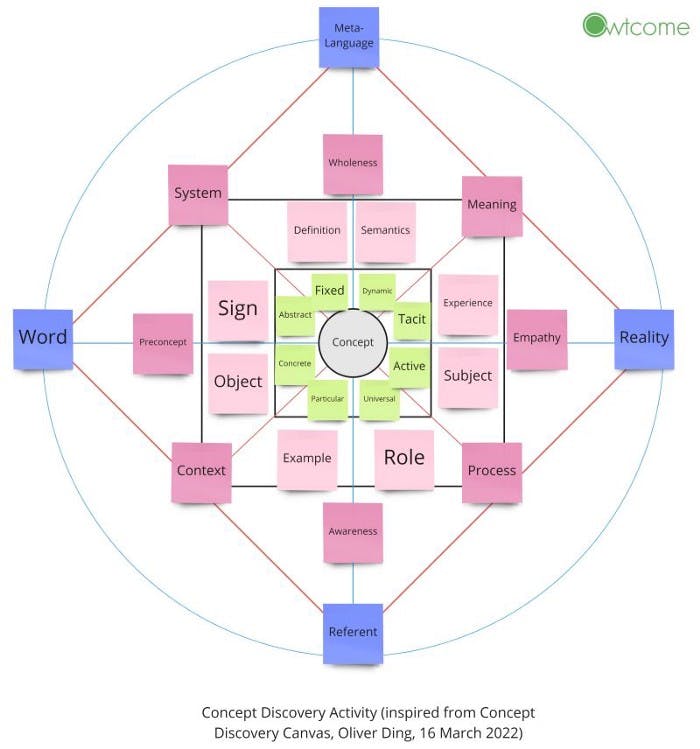Skip to content
More
Share
Explore

#8 —The “Thematic Spirit” Activity
Significant Insight
Daiana Zavate was in Rome while I was in Houston. We started our tiny real-time global collaboration on Miro at 1:30 pm.


Daiana Zavate has been following my writing for several months. After reading and reproducing her version of the canvas, I was sure that she understood the spatial structure of the Thematic Space Canvas. I also read her creations of concept development about strategic design thinking. I believe she is a talent for conceptual thinking.
Since we share the same knowledge about Thematic Space Canvas and Concept Development, our first collaboration went quite well.
Our first task is setting a new framework that frames the three-step flow for our three diagrams.
Phase 1 is defining learning and understanding Others’ concepts. It’s for building a knowledge base for a particular topic or an issue. We directly used my original Concept Discovery Canvas (v1.0) for it and didn’t make any changes. I renamed it Concept Evaluation Canvas.


Phase 2 is about creating a brand new concept. This is the core of the whole flow. So we decided that we us So we decided that we use Concept Discovery as a name for this phase. Since we can use the third canvas for communication, I removed “four orders of design” from the Concept Discovery Canvas. I thought we can emphasize Concept Creation Strategies for this canvas, we can use Four Types of Strategies to define four areas. However, we don’t have enough time to find and decide on the content of the Four Types of Strategies.


Thus, the major task of the collaboration is redesigning the third canvas.


At 2:30 p.m., we completed the whole canvas. This is an awesome collaboration. We did it in just an hour!!! You can find more details
.After six hours, I realized that we also created a new activity about the Thematic Space Canvas. I called it Thematic Spirit.


In Feb 2022, I reviewed the Developing Tacit Knowledge project and used the above diagram to curate my creations about Thematic Space. Now I can add “Thematic Spirit” to the diagram.
Method


The above model is called the Relevance of Zone which considers Other as an important social context for the long-term development of thoughts. You can find more details
.Based on the model, we can generate the following questions:
The following section will use these questions to guide our reflection.
Analysis
Other: Who is the Significant Other for this insight?
Daiana Zavate is the Significant Other for this insight because we co-created the “thematic spirit” activity.
Daiana Zavate has been following my writing for several months. After reading and reproducing her version of the canvas, I was sure that she understood the spatial structure of the Thematic Space Canvas. I also read her creations of concept development about strategic design thinking. I believe she is a talent for conceptual thinking.
Since we share the same knowledge about Thematic Space Canvas and Concept Development, our first collaboration went quite well.
Thing: What’s the insight about? Why do I pay attention to it?
The concept discovery canvas is based on the Thematic Space Canvas which is a meta-canvas.
The Thematic Space Canvas is part of the Slow Cognition project which focuses on Developing Tacit Knowledge.
I use the Activity-theoretical approach to understand “Developing Tacit Knowledge”. While Thematic Space Canvas is a Mediating Instrument, the “Thematic Spirit” is a new form of activity.
Think: How did I get this insight? Is there a technique behind the process?
The insight is born from open collaboration and self-reflection.
On March 19, 2022, I shared the Concept Discovery Canvas (v1.0) . I mentioned who is the Concept Lead at in the comment area of the post.
To my surprise, she made a new version of the canvas and called it Concept Discovery Activity. Then we had a lively discussion in the comment area of her post.


Daiana Zavate’s version of Concept Discovery
Following up on ’s Concept Discovery Canvas (link below), I thought about what I would prioritize in a Concept Discovery Activity that could prove useful in mapping concepts. While the CDC is a fitting practice for observing the complex ties of theory to practice and a great starting point for curation practices, I was curious if there can be more points of convergence to show the irregularity of some concepts, especially when we don’t know (yet) what that concept could be.
This framework is just an experimental playground and by no means complete, but it was a nice introspection to visualize my thoughts on some concepts and their ambiguity.
Daiana Zavate
Her canvas encourages me to reflect on the name “Concept Discovery” of my original version. I made some comments that led to a new version of Concept Discovery Canvas (v2.0).
Later, I reproduced her canvas on a Miro board and made new comments with several questions.
Finally, we moved to the board and run a real-time collaboration of making a new canvas.
There are two types of reflection: Practice-based Reflection and Theory-base Reflection.
After six hours, I realized that we also created a new activity about the Thematic Space Canvas. I called it Thematic Spirit.


In Feb 2022, I reviewed the Developing Tacit Knowledge project and used the above diagram to curate my creations about Thematic Space. Now I can add “Thematic Spirit” to the diagram.
This technique is called Theory-based Reflection. The Activity-theoretical perspective and the above Themes of Practice framework are theoretical resources. I used them to guide my reflection on the experience of playing with the thematic space canvas.
Self: Where did I capture this insight?
Daiana Zavate and I discussed this on Linkedin, then we moved to Miro.
I captured this insight in my house.
Self: When did I capture this insight?
On March 18, 2022, Daiana Zavate and I run the first Thematic Spirit for one hour.
Daiana Zavate was in Rome while I was in Houston. We started our tiny real-time global collaboration on Miro at 1:30 pm.
At 2:30 p.m., we completed the whole canvas. This is an awesome collaboration.
After six hours, I realized that we also created a new activity about the Thematic Space Canvas. I called it Thematic Spirit.
Activity: Is this insight part of an activity? What’s the activity?
The “Thematic Spirit” Activity is part of the Thematic Space Project which is a large Knowledge Enterprise that contains the follow ideas.
t contains the following ideas:


For Curativity Theory, the notion of Thematic Spaces is a new theoretical concept that is part of the Knowledge Curation framework. Also, Themes of Practice is a sub-theory of Curativity Theory, the notion of Thematic Spaces is also part of the Themes of Practice framework.
The notion of Slow Cognition refers to the long-term development of thoughts and the historical-cognitive method. The notion of Thematic Spaces is a great tool for turning the notion of Slow Cognition from a concept into a project.
Activity: Has this insight led to a new action or a new activity?
This is part of the Thematic Space Project.
Want to print your doc?
This is not the way.
This is not the way.

Try clicking the ⋯ next to your doc name or using a keyboard shortcut (
CtrlP
) instead.